Key takeaways:
- Coalition building relies on creating unity through shared vision and empathetic dialogue among diverse groups.
- Effective advocacy for gender equality transforms individual lives and fosters economic growth by promoting inclusivity.
- Building trust and open communication with partners enhances collaboration and strengthens coalitions.
- Measuring coalition effectiveness can be done through monitoring policy changes, internal dynamics, and community engagement.
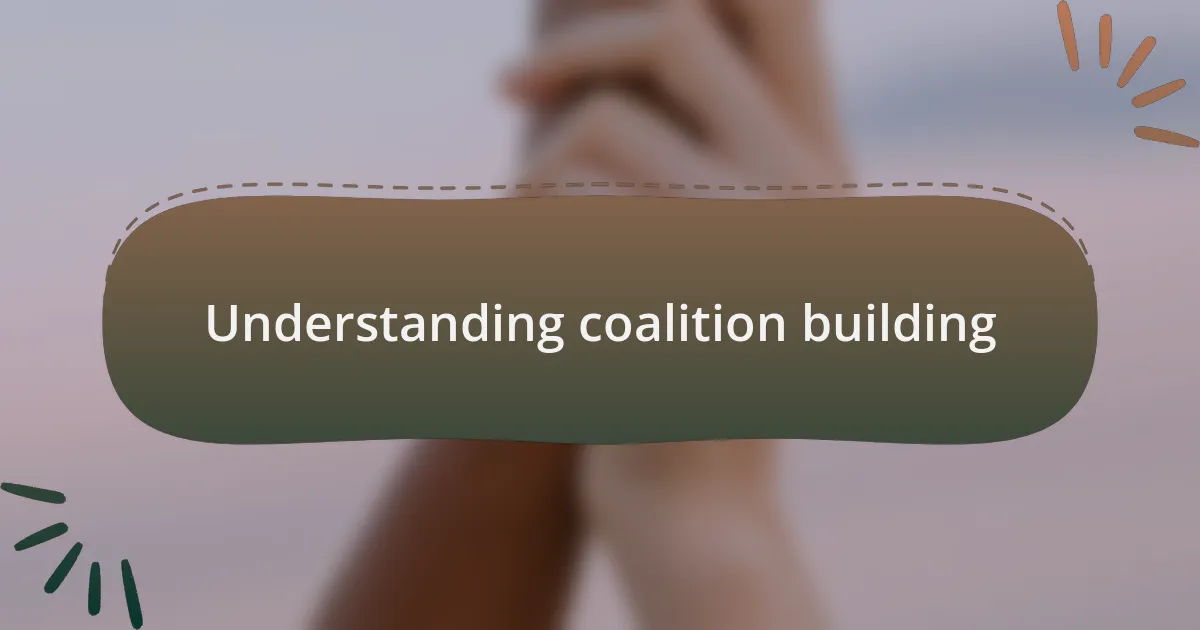
Understanding coalition building
Coalition building is fundamentally about creating unity from diversity. I remember my first attempt at bringing together various groups with differing viewpoints. It was enlightening to witness how much common ground we truly shared, despite apparent differences. This experience made me appreciate the power of dialogue and understanding in creating a cohesive coalition.
When I think about coalition building, I feel that the essence lies in shared vision and goals. Have you ever tried to work with someone who saw the world very differently from you? It can be challenging yet incredibly rewarding when you find a way to align objectives. During one project, our group spent hours discussing our visions, and through this, we not only discovered mutual interests but also deepened our relationships, which is crucial for any coalition’s success.
Moreover, effective coalition building demands patience and trust. I recall a particularly frustrating meeting where it seemed progress had stalled. It was then I realized that building connections requires time and persistent effort. It’s not just about the immediate outcomes; it’s about nurturing those relationships to create lasting change in advocacy efforts. What do you think is the most important trait for someone involved in coalition building? For me, it’s about empathy and the willingness to truly understand different perspectives.
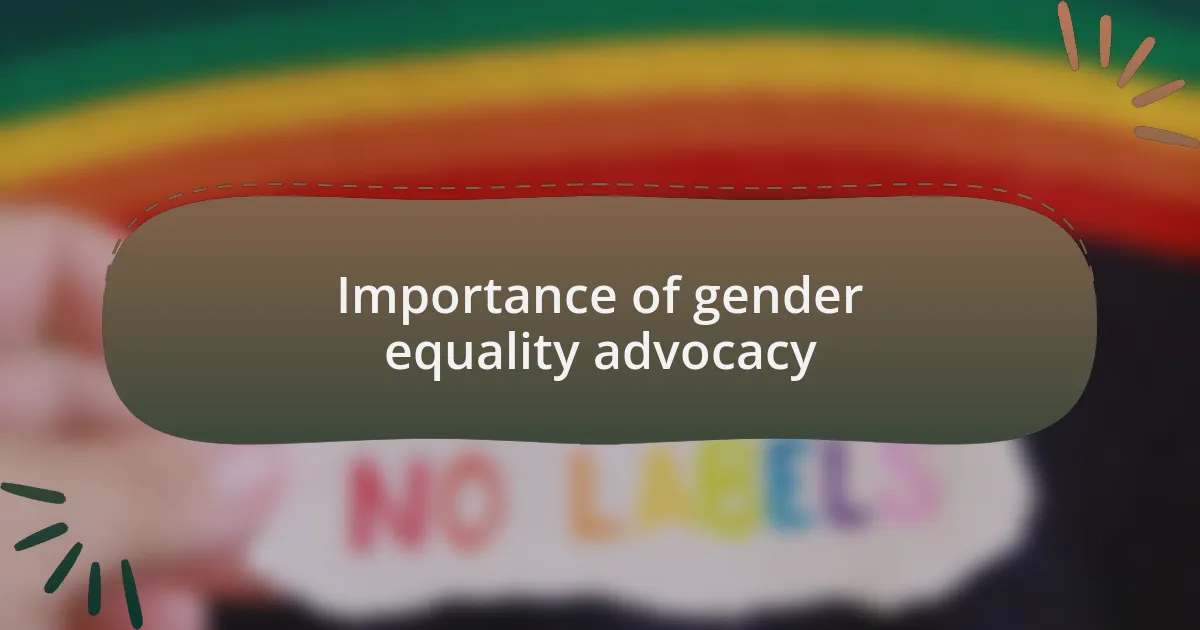
Importance of gender equality advocacy
Gender equality advocacy is crucial because it directly impacts the fabric of society. I vividly remember attending a seminar where a speaker shared her story about facing workplace discrimination. Hearing her experiences not only moved the audience but also highlighted how deeply ingrained biases can limit opportunities. This reinforces my belief that advocacy isn’t just about policy changes; it’s about transforming individual lives.
I often reflect on the ripple effect of promoting gender equality. When I volunteered at a local women’s shelter, I saw firsthand how empowering women can change entire families and communities. It made me think, what if everyone had access to equal opportunities? This thought fuels my passion for advocacy, as I’ve witnessed the profound changes that can arise when gender equality is prioritized.
Moreover, gender equality advocacy is essential for fostering economic growth. Studies show that organizations with greater gender balance tend to outperform their peers. Based on my experience, I’ve observed that inclusive environments lead to more innovative solutions. Isn’t it fascinating how supporting gender equality can not only uplift individuals but also drive success at broader levels?
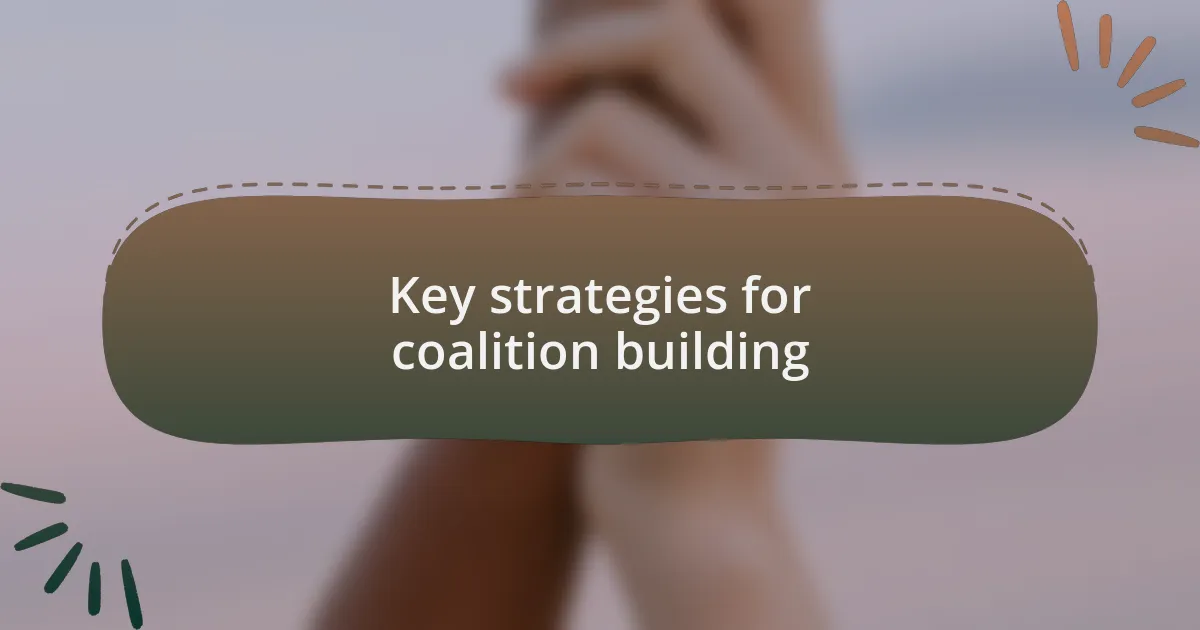
Key strategies for coalition building
Building a coalition effectively requires establishing trust among all parties involved. I remember my first collaborative project, which involved various organizations passionate about gender equality. By dedicating time to listen to each member’s concerns and aspirations, I noticed a profound shift in our dynamics; we were no longer just representatives of our organizations, but allies united by a shared mission.
Another crucial strategy is to define common goals clearly from the outset. During a workshop, I facilitated a brainstorming session where participants shared their visions for gender equality. It was eye-opening; even though each organization had a unique perspective, we ultimately discovered overlapping objectives. This realization not only strengthened our coalition but also enhanced our commitment to the cause.
Lastly, ongoing communication is vital for coalition sustainability. In a previous initiative, I made it a practice to send regular updates, celebrate small wins, and address any challenges transparently. This approach fostered a sense of belonging and accountability among coalition members. Isn’t it amazing how keeping the lines of communication open can transform a group of individuals into a cohesive unit working towards a common purpose?
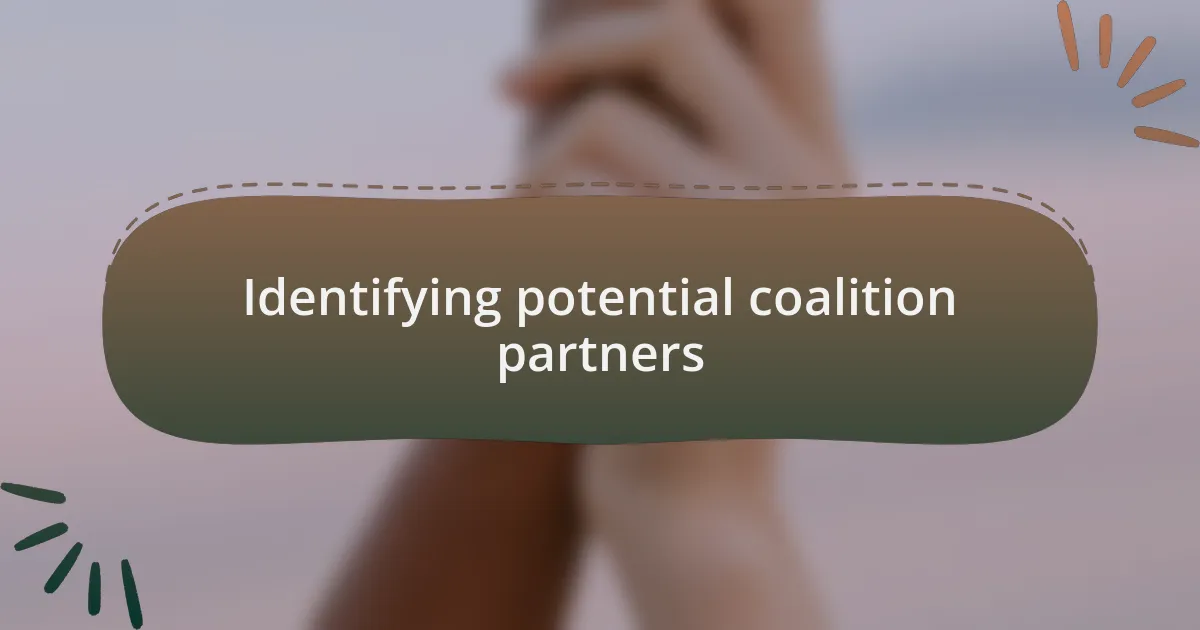
Identifying potential coalition partners
Identifying potential coalition partners begins with understanding the landscape of organizations already engaged in gender equality work. I recall attending a local conference where I engaged in conversation with representatives from different sectors. It struck me how many shared values emerged simply through informal dialogue. Have you ever found common ground with someone unexpected? That moment can spark new opportunities for collaboration.
Another effective strategy is to assess the strengths and weaknesses of potential partners. In one instance, I collaborated with a youth-led organization that brought fresh energy and innovative ideas. Their insights challenged my own perceptions and infused our coalition with creativity. I learned that bringing in partners with diverse strengths often leads to more robust solutions. So, what unique strengths do you think your potential partners might offer?
It’s also important to consider the existing relationships within your network. I often leverage connections I’ve built over the years to identify partners who not only share my commitment to gender equality but also possess the credibility and influence to effect change. One time, a simple introduction led to a powerful partnership that made a significant impact in our community. Who in your network might help bridge gaps? Recognizing these connections can open new doors to collaboration, making the path to coalition-building smoother.
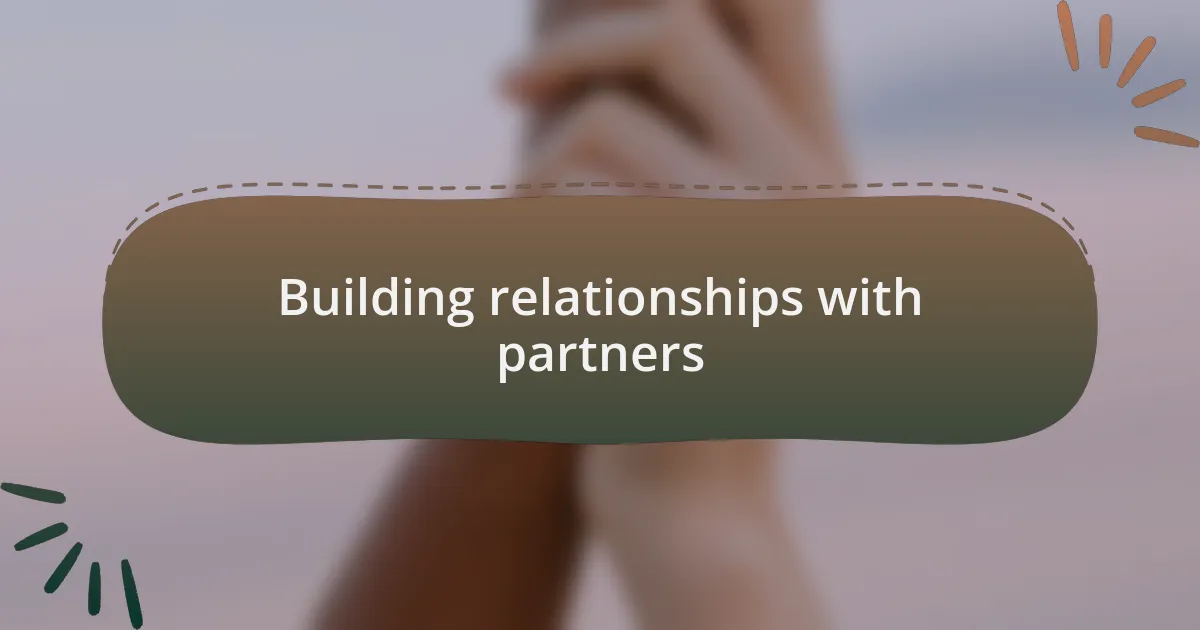
Building relationships with partners
Building relationships with partners starts with genuine communication and trust. I remember meeting a potential ally over coffee, where we shared not just our visions but also our personal journeys. It was in that vulnerable exchange that I truly felt the strength of our connection and how crucial trust is in coalition building. Have you ever experienced that moment of understanding that shifts a conversation from business to partnership?
Collaboration can flourish when partners share their stories openly. I once joined forces with an organization that struggled with similar challenges we faced, and together, we discovered a shared mission. This exchange not only enhanced our strategies but also fostered a sense of camaraderie. How often do you share your own challenges with potential partners? This openness can break down barriers and lead to innovative solutions.
Nurturing these relationships requires ongoing engagement and follow-up. After my initial conversations, I made it a point to check in regularly, providing updates and asking for their insights. One partner surprisingly offered invaluable feedback that significantly shaped our initiatives. What steps can you take to keep the lines of communication open? Building a strong rapport can transform partners into dedicated allies, ready to work toward common goals.

Engaging stakeholders in advocacy
Engaging stakeholders in advocacy means recognizing that these individuals or organizations have unique perspectives and motivations. I vividly recall a workshop where I facilitated discussions among diverse stakeholders. It was enlightening to see how sharing our different viewpoints not only enriched our understanding but also sparked new ideas. Have you ever sat in a room with people who challenged your assumptions? That discomfort often leads to growth.
To ensure effective engagement, I’ve learned the power of active listening. During a community meeting, I made it a priority to genuinely hear the concerns of participants instead of immediately presenting my agenda. This practice fostered trust and encouraged stakeholders to voice their opinions openly. What happens when you listen intently? You create a space where all voices matter, paving the way for collaborative action.
Moreover, the follow-up is crucial in maintaining stakeholder engagement. After our initial discussion on a pressing gender equality issue, I sent personalized thank-you notes that referenced specific contributions each person made. This simple act reaffirms their value in the process and keeps the momentum going. How often do you reflect on the contributions of your stakeholders? Acknowledgment can turn a mere interaction into a lasting partnership, enriching the advocacy journey for everyone involved.
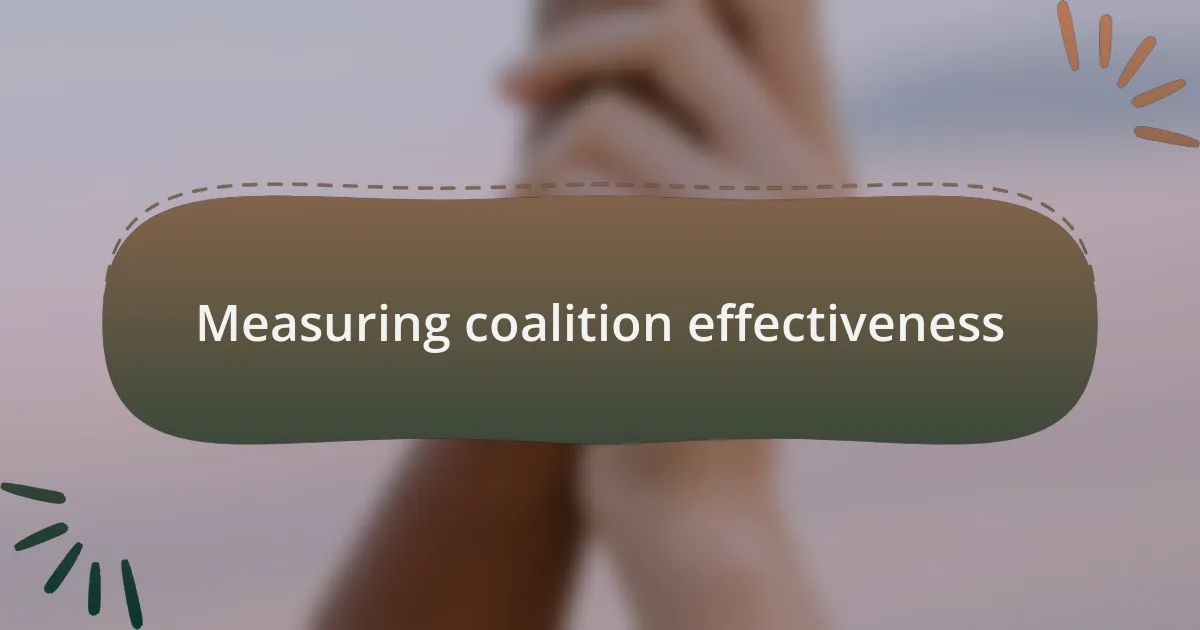
Measuring coalition effectiveness
Measuring coalition effectiveness can often feel like navigating a maze without a map. In my experience, one of the most practical metrics involves tracking the coalition’s impact on policy changes over a defined period. For instance, I once collaborated with a coalition that focused on improving gender-based violence legislation. We carefully monitored legislative proposals and eventually celebrated a significant law being passed, a clear sign that our collective efforts were not just noise, but effective action.
Another dimension to consider is the dynamics within the coalition itself. I remember a time when we utilized an anonymous feedback system to gauge the satisfaction of our members. The insights we gathered were revealing; they highlighted not only areas of strength but also aspects that needed improvement. What does effective communication within a coalition look like? It includes openness, trust, and a willingness to adapt based on collective feedback.
Lastly, I find it essential to evaluate the coalitions’ ability to mobilize and inspire constituents. During a campaign for awareness on gender equality, we observed a marked increase in community participation, with many individuals sharing their stories. It made me realize that a coalition’s effectiveness can often be measured by the extent to which it empowers people to take action. So, how do you ensure that your coalition connects with its members on an emotional level? Engaging narratives can turn statistics into relatable stories, and that’s where the magic often begins.